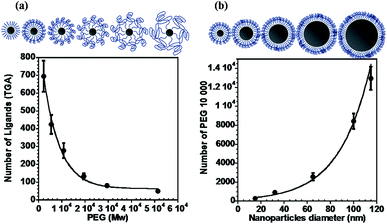 Open Access Article
Open Access ArticleCreative Commons Attribution 3.0 Unported Licence
Correction: PEGylated gold nanoparticles: polymer quantification as a function of PEG lengths and nanoparticle dimensions
Kamil Rahme*abc,
Lan Chenabd,
Richard G. Hobbsab,
Michael A. Morrisab,
Caitriona O'Driscolle and
Justin D. Holmesab
aMaterials Chemistry and Analysis Group, Department of Chemistry, The Tyndall National Institute, University College Cork, Cork, Ireland
bCentre for Research on Adaptive Nanostructures and Nanodevices (CRANN), Trinity College Dublin, Dublin 2, Ireland
cDepartment of Sciences, Faculty of Natural and Applied Science, Notre Dame University (Louaize), Zouk Mosbeh, Lebanon. E-mail: kamil.rahme@ndu.edu.lb; Fax: +961 9 225164; Tel: +961 9 218950
dDepartment of Chemical Engineering and Biotechnology, University of Cambridge, Pembroke Street, Cambridge, CB2 3RA, UK
ePharmacodelivery Group, School of Pharmacy, University College Cork, Cork, Ireland
First published on 27th January 2017
Abstract
Correction for ‘PEGylated gold nanoparticles: polymer quantification as a function of PEG lengths and nanoparticle dimensions’ by Kamil Rahme et al., RSC Adv., 2013, 3, 6085–6094.
The authors regret that the surface area calculation of the grafting density was originally calculated using πr2 instead of 4πr2. This error does not affect the overall conclusions of this paper. Furthermore, the correct surface area was used in the calculation of the polymer conformation. The corrected grafting densities and foot prints have been included below.
In the abstract, the decrease in grafting density of the mPEG-SH ligands should read “0.983 to 0.07 PEG per nm2” and the decrease in grafting density of the mPEG10![[thin space (1/6-em)]](https://www.rsc.org/images/entities/char_2009.gif) 000-SH should read “0.393 to 0.2 PEG per nm2”.
000-SH should read “0.393 to 0.2 PEG per nm2”.
The data in Table 2 should read:
Table 2. Surface coverage (from TGA) and mPEG-SH layer thickness (from DLS size distribution by volume) on 15 nm gold nanoparticles
| mPEG-SH (Mw) | Number of EO | DLS (v)/PEG layer (nm) | Weight loss (%) T > 320 °C | NPEG per 15 nm AuNP | Foot print (nm2) | Grafting density per nm2 |
|---|---|---|---|---|---|---|
| 2100 | 47 | 2.83 ± 0.66 | 6.7 | 695 ± 87 | 1.02 | 0.983 |
| 5400 | 122 | 7.79 ± 1.0 | 9.9 | 424 ± 53 | 1.67 | 0.6 |
10![[thin space (1/6-em)]](https://www.rsc.org/images/entities/char_2009.gif) 800 800 |
245 | 12.77 ± 1.5 | 12 | 278 ± 42 | 2.54 | 0.393 |
19![[thin space (1/6-em)]](https://www.rsc.org/images/entities/char_2009.gif) 500 500 |
443 | 21.61 ± 2.5 | 10.82 | 132 ± 16.5 | 5.35 | 0.187 |
29![[thin space (1/6-em)]](https://www.rsc.org/images/entities/char_2009.gif) 500 500 |
670 | 25.6 ± 3.0 | 10 | 81 ± 10 | 8.77 | 0.114 |
51![[thin space (1/6-em)]](https://www.rsc.org/images/entities/char_2009.gif) 400 400 |
1168 | 37.15 ± 4.0 | 10.85 | 50 ± 6 | 14.2 | 0.07 |
The data in Table 3 should read:
Table 3. Surface coverage (from TGA) of different AuNPs diameter (EM/DLS) coated with mPEG10![[thin space (1/6-em)]](https://www.rsc.org/images/entities/char_2009.gif) 000-SH
000-SH
| Diameter (nm)/EM | Diameter (nm)/DLS (I) | Weight loss (%) T > 320 °C | NPEG/AuNP | Foot print (nm2) | Grafting density per nm2 |
|---|---|---|---|---|---|
| 15 ± 1.8 | 59 ± 3.5 | 14.25 | 278 ± 42 | 2.54 | 0.393 |
| 30 ± 3.5 | 72 ± 5 | 5.7 | 916 ± 106 | 3.12 | 0.323 |
| 62.5 ± 6 | 102 ± 9 | 1.64 | 2572 ± 402 | 5 | 0.2 |
| 93 ± 12 | 138 ± 10 | 1.41 | 6778 ± 814 | 4.2 | 0.24 |
| 115 ± 10 | 165 ± 14 | 1.449 | 12![[thin space (1/6-em)]](https://www.rsc.org/images/entities/char_2009.gif) 960 ± 1227 960 ± 1227 |
3.2 | 0.312 |
Fig. 5 should be replaced by the following figure:
The text also affects the discussion of Fig. 5 on page 6091 which should read:
“Specifically, the number of PEG molecules grafted to the Au nanoparticles decreased by ∼12 fold from 695 ± 87 for mPEG2000-SH (0.983 PEG per nm2) to 50 ± 6 for mPEG48![[thin space (1/6-em)]](https://www.rsc.org/images/entities/char_2009.gif) 500-SH (0.07 PEG per nm2). The solid line is an exponential fit to the data. Increased conformational entropy of the PEG molecules with polymer chain length leads to an increase in the footprint of the PEG molecules at the Au nanoparticle surface from 1.02 nm2 for mPEG2000-SH to 14.2 nm2 for mPEG48
500-SH (0.07 PEG per nm2). The solid line is an exponential fit to the data. Increased conformational entropy of the PEG molecules with polymer chain length leads to an increase in the footprint of the PEG molecules at the Au nanoparticle surface from 1.02 nm2 for mPEG2000-SH to 14.2 nm2 for mPEG48![[thin space (1/6-em)]](https://www.rsc.org/images/entities/char_2009.gif) 500-SH (see Table 2)
500-SH (see Table 2)
The text discussing mPEG10![[thin space (1/6-em)]](https://www.rsc.org/images/entities/char_2009.gif) 000-SH on the same page also requires amendment:
000-SH on the same page also requires amendment:
Finally, some similar behaviour has been observed in this work where the grafting density of mPEG10![[thin space (1/6-em)]](https://www.rsc.org/images/entities/char_2009.gif) 000-SH was higher on 15 nm diameter Au nanoparticles and decreased slightly from 0.393 to 0.2 PEG per nm2 when the particle size increased to 65 nm in diameter (Table 3).”
000-SH was higher on 15 nm diameter Au nanoparticles and decreased slightly from 0.393 to 0.2 PEG per nm2 when the particle size increased to 65 nm in diameter (Table 3).”
The last three lines on page 3 of the ESI should read:
“So from this experiment we estimate that 15 nm AuNPs contain 278 PEG10![[thin space (1/6-em)]](https://www.rsc.org/images/entities/char_2009.gif) 000-SH. The grafting density correspond to 278/706.84 ∼ 0.393 PEG10
000-SH. The grafting density correspond to 278/706.84 ∼ 0.393 PEG10![[thin space (1/6-em)]](https://www.rsc.org/images/entities/char_2009.gif) 000 per nm2 and finally the foot print of the PEG10
000 per nm2 and finally the foot print of the PEG10![[thin space (1/6-em)]](https://www.rsc.org/images/entities/char_2009.gif) 000 correspond to 1/0.393 ∼ 2.54 nm2.”
000 correspond to 1/0.393 ∼ 2.54 nm2.”
The Royal Society of Chemistry apologises for these errors and any consequent inconvenience to authors and readers.
| This journal is © The Royal Society of Chemistry 2017 |

